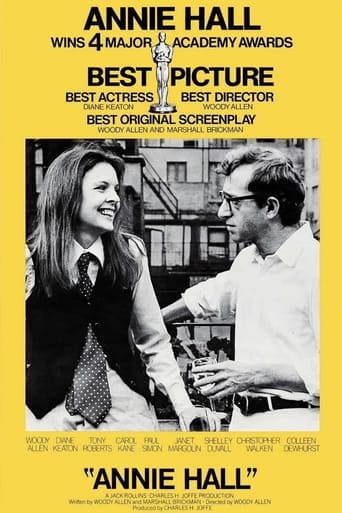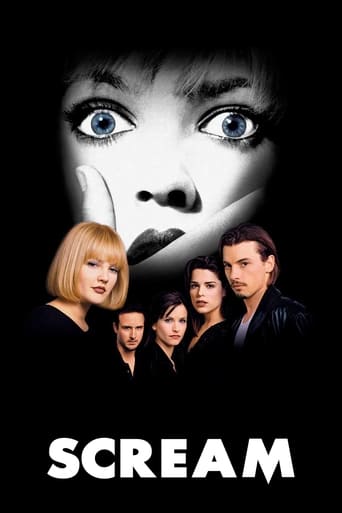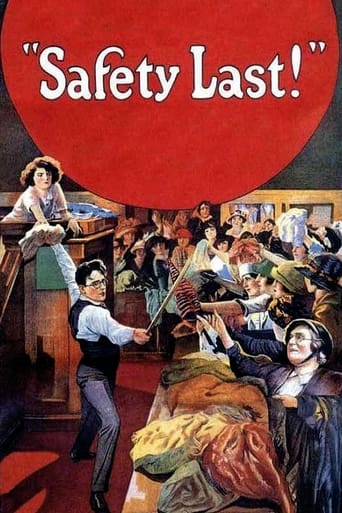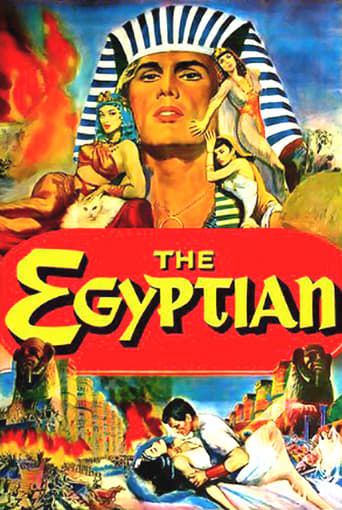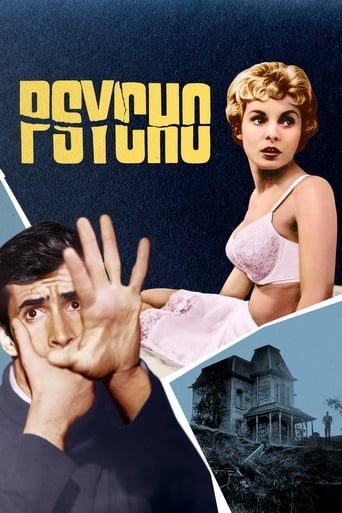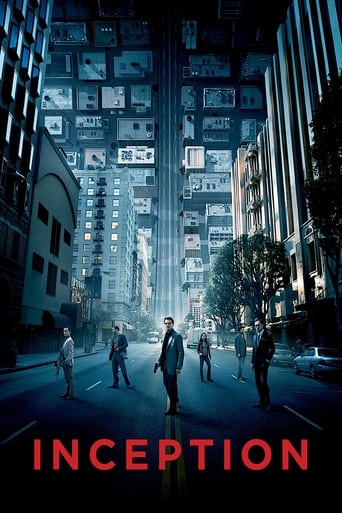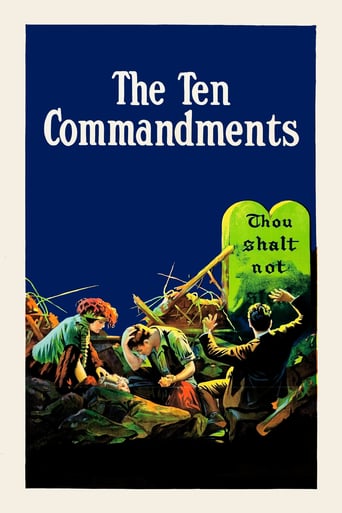


The Ten Commandments
The first part tells the story of Moses leading the Jews from Egypt to the Promised Land, his receipt of the tablets and the worship of the golden calf. The second part shows the efficacy of the commandments in modern life through a story set in San Francisco. Two brothers, rivals for the love of Mary, also come into conflict when John discovers Dan used shoddy materials to construct a cathedral.
-
- Cast:
- Theodore Roberts , Charles De Rochefort , Estelle Taylor , Julia Faye , Pat Moore , James Neill , Lawson Butt


Similar titles
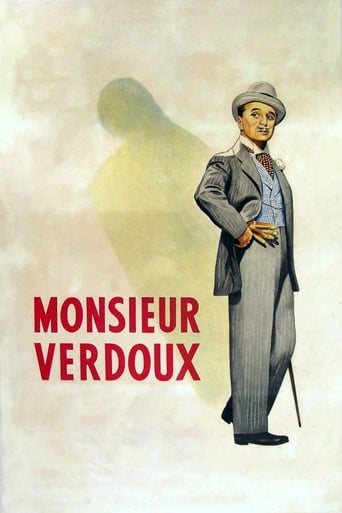
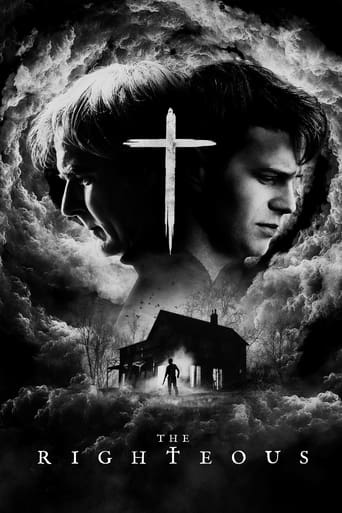
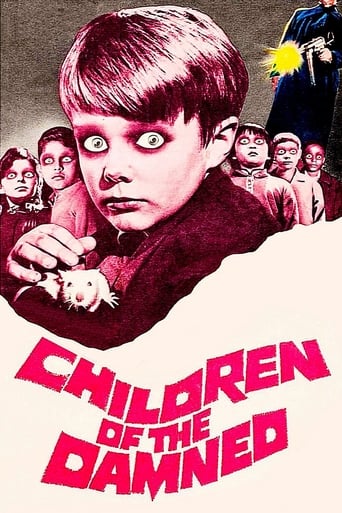




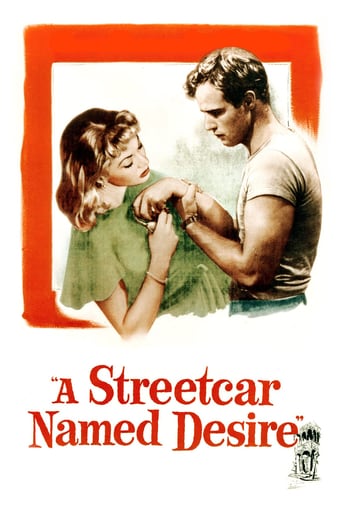
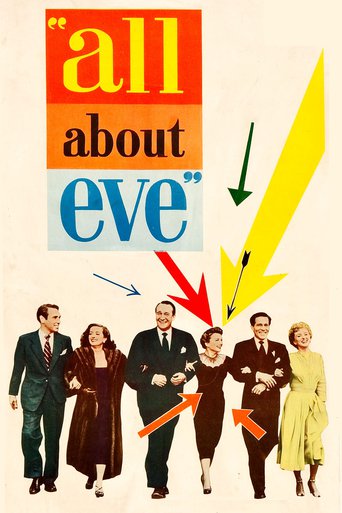
Reviews
I wanted to but couldn't!
Awesome Movie
It's entirely possible that sending the audience out feeling lousy was intentional
All of these films share one commonality, that being a kind of emotional center that humanizes a cast of monsters.
This was another Biblical epic from the Silent era which I had long wanted to check out; even so, I had owned the DVD (accompanying the more popular 1956 version of the same events, from the same showman director no less, and which has received countless viewings from yours truly) for some time before I finally got to it. As with the later NOAH'S ARK (1928), virtually watched simultaneously, it seems that film-makers of the time were unsure of the appeal of such religious epics, so that they had to present them within the context of a modern story; still, De Mille's THE KING OF KINGS (a milestone in itself for being the first and, for a time, only picture to show Jesus' face) preceded that Michael Curtiz work by a year and it was set exclusively in the time of Christ. In this case, only the first 50 minutes or so are dedicated to the familiar tale involving Moses (needless to say, the dull Theodore Roberts is no match for the stoic Charlton Heston in the remake): the exodus, the parting of the Red Sea, the writing of the tablets and the Golden Calf; these are clearly heavily streamlined in comparison with the almost 4-hour long 1956 THE TEN COMMANDMENTS and, in spite of their obvious care, gargantuan scale and excellent special effects, can feel unsatisfying in that respect...especially when the parallel story is so hokey, unnecessarily inflated and, at the end of the day, somewhat ordinary! The latter sees a Bible-thumping matriarch (which she proudly holds even when posing for a portrait), her two sons and the girl who comes between them: one of the boys (played by Richard Dix) is righteous – and, as his mother claims, engaged in a skill (carpentry) which has produced some notable exponents (alluding naturally to Christ himself) – while the other mocks religion and vows to become somebody by his own merits. Eventually, we find him as a top contractor and, perhaps to make amends, takes it upon himself to build a church; however, to cut costs, he reduces the amount of cement required to make the concrete, with the result that the walls are weak and liable to collapse at any time (coincidentally, the very previous day I watched a film in which a character had faced a similar dilemma – GIVE US THIS DAY aka Christ IN CONCRETE [1949]): this ruse is discovered by Dix, appointed "boss-carpenter" on the project, and he confronts his brother but, before anything can be done about it, the whole edifice falls on top of the mother who picks just that moment to visit the premises! The morally-corrupt sibling even forsakes his wife (the destitute girl they had taken in and whom Dix relinquished on his account) for an Asian temptress, whom he eventually kills (the only commandment, according to his spouse, not yet broken by him); in the end, the boy gets his come-uppance and Dix can reclaim his lady. While the two sections may seem to jell better than those in NOAH'S ARK, the overall achievement is a lesser one – and not just to it, but THE KING OF KINGS (by the way, Christ makes a 'cameo' appearance here towards the end!) and, most importantly, the later version if still quite worthwhile in itself.
The Ten Commandments marks the beginning of the second wave of the Hollywood epic. Modelled on the contemporary/ancient parallel storytelling of Intolerance the crowning achievement of the first wave and its subject matter decided by a poll of cinema-goers, this is among the most significant and typically DeMillean of DeMille's pictures.DeMille had first coupled a historical tale with a modern day framing story in 1916's Joan the Woman, and even during the years when the historical feature was out of fashion (approximately 1918 1921) he several times added a little metaphorical foray into the past to his contemporary dramas, such as Male and Female and Manslaughter. Here, it is still the modern day narrative which makes up the bulk of the picture's 130-odd minutes, and yet it is the spectacular biblical prologue that everyone remembers.DeMille had always had a talent for directing crowd scenes, giving inspiring pep talks to the mass whilst giving specific directions to the individuals. Here he works with the biggest group of extras he had ever handled, and yet he has lost none of his touch. He gives character to the multitude by focusing on a number of individuals within it, and yet when he pulls back to show the whole crowd you can still see the attention to detail, with a hundred different things going on. The stupendous sets also make an impact in themselves, but DeMille is shrewd enough to reveal them gradually, and places them squarely in the context of being symbolic of evil. The pharaoh's palace may be impressive, but DeMille ensures that the works of God the pillar of fire, the parting of the red sea, the lightning on Sinai are more so. Oddly, he could be accused of doing the opposite in his 1956 remake, in which the Egyptian city is absolutely awe-inspiring, whereas the special effects representing acts of God are somewhat pathetic even for the day, and certainly less effective than those in 1923. But DeMille had changed a lot by that time.In contrast to the prologue, the contemporary story is somewhat lacklustre. It has much in common with other DeMille dramas from around this period, although it is pretty mediocre by that standard. Particularly jarring is the overuse of intertitles. Five years earlier DeMille had been a master of purely visual narrative, and the titles were only there when absolutely necessary. As time went by however, as DeMille had become more pious and his screenwriter Jeanie Macpherson had become more pretentious, so had the photoplays become more wordy. All the better for preaching with, as far as self-appointed messenger-of-God DeMille was concerned, but his pictures began to lack the grace and smoothness they had once had.With scenes fragmented into smaller pieces, and characters unable to open their mouths without a superfluous title spelling their words out to the audience, the acting also suffers. Richard Dix, Rod La Rocque, Leatrice Joy and Nita Naldi are all adequate performers, but none of them really gets time or space to emote as much as they ought to for the story. Nevertheless, DeMille was still a master of the powerful, iconic image, and there are enough memorable shots here to keep things interesting. Among the standouts are Nita Naldi's hands emerging from a tear in a sack, the straight-up shot in the lift as Leatrice Joy ascends and Naldi ripping the curtain off its hooks, nearly forty years before the almost identical shot in Hitchcock's Psycho. It is images like this which reign supreme in DeMille's cinema, and it is from around this point on that they become more important than the credibility of the story or the actors.DeMille's Ten Commandments proved to be highly influential. Other studios got to work on their own superproductions, the western would become epic with The Iron Horse, and even Douglas Fairbanks next picture, The Thief of Bagdad, was steeped in DeMillean grandeur. Further afield, UFA studios in Germany and Abel Gance in France were also working on the principle that big is beautiful. Ten Commandments indicated the future for DeMille himself as well. Not only was it the first of the pictures that would secure his legacy as the ultimate biblical filmmaker, but the fact that the prologue is absolutely breathtaking and the contemporary drama lacks bite, hints towards his eventually becoming a director purely of epics. It's also rather telling that he loved the Old Testament God of plagues and smiting, because that is probably more or less how DeMille saw himself. He hammered home his messages with the spectacular and the incredible. A shock-and-awe filmmaker preaching the word of a shock-and-awe God.
this is the first film version of The Ten Commandments.it is directed by Cecil B.Demille,who also directed the 1956 version.this version is very lean,going through the events of that time,very quickly.in 50 minutes,in fact.i'm guessing they just kept the essentials of the story,without anything extra.the special effects are quite something for that day.the film must have been a grand undertaking.the remaining 80 minutes or so is a morality play set in more modern times(around 1923,i'm guessing)concerning how the Ten Commandments relate to modern life,and what happens if we don't obey them.for me,this second half is just way too heavy handed and preachy.the message is a good one,but it feels like you're being hit over the head with sledgehammer.some of the acting may seem a bit exaggerated,but they had to act that way,since they didn't have sound.there is an orchestral accompaniment,that plays through out the film.the only problem is,i found the music too repetitive.it got annoying after awhile.still,considering that this movie was mad in 1923,it's not too bad.my vote for The Ten Commandments(1923)is a 6/10
Director: Cecil B. Demille, Script: Jeaine Macpherson, Cast: Theodore Roberts (Moses), Charles de Rochfort (Rameses), Estelle Taylor (Miriam,sister of Moses), Julia Faye (wife of pharaoh), James Neill (Aaron), Edythe Chapman (Mrs. Martha Mc Tavish), Richard Dix (John,son), Rod La Rosque (Dan,son), Nita Naldi (Sally Lung,Eurasian)Most people today have probably never seen this film. It is now available on the 50th anniversary set with the 1956 version. The 1956 version was an amazing movie but in many ways I prefer this one, Cecil B Demille's 1923 original. Many people will be surprised upon first viewing of this film. Demille uses a different approach thin in his 1956 remake. This film has two parts. The first part is set during the time of the exodus in the old testament. The Hebrew nation is enslaved by the Egyptians under the ruthless rule of the pharaoh Rameses. Moses as the chosen leader of the Jews frees his people from the Egyptians. God gives him the power to inflict plagues upon the Egyptians. He then leads his people on the great exodus across the desert to the Red Sea. God gives him the power to part the sea so the Jewish people can cross. Phaorah orders his army to go after the Jews across the parted Red Sea but God had the sea 'return to normal' so the army drowns.Make no mistake, this film was a major production in its day and very high budget for its time. Demille uses very elaborate sets for this production. The exterior wall of the great Egyptian city is just like the one used in the 1956 version. Many extras were used in the making of this film. During the great exodus, there appears to be people for as far as the eye can see. You can see this great line of people spread out across the desert. Camels were seen during the exodus but as it turns out, camels were not in the middle east during that time period. The parting of the Red Sea in the 1956 version was considered an amazing special effect for its time. I was very curious as to how they would be able to pull this off in 1923! I was quite amazed!! The special effects used for the parting of the sea is just as good as the 56 perhaps better. One thing I really like about the special effects of this film is the wall of fire that Moses creates to keep the Egyptian army at bay. In the 56 version animation was used for the fire. In this version real fire was used using a double exposure technique that I thought was more impressive. Mr Demille was very loyal to his actors. He would use many of the same actors in a number of his films. The women who plays the part of pharaoh's wife and the boy that played his son are both involved in the 56 version as well as the film editor.The film switches gears totally for the second half. We are now in modern times. It starts with a mother reading passages from the book of Exodus to her two sons. All the drama from the first half was simply her reading being acted out. The rest of the film is a morality tale between two sons. The mother and one son are deeply religious while the other son is a nonbeliever. He makes fun of his brother's silly beliefs so the mother kicks him out of the house for being a heathen. The believing son lives a modest life while the unbelieving son becomes very wealthy. He even gets the women they both like! He becomes a wealthy contractor employing his brother as a worker. However, the unbelieving brother's life will be filed with misfortune eventually leading to his death. The twist in the second half of the film makes for a interesting viewing experience. I like the contrast between ancient and modern times. Katherine Orrison in her commentary states that the modern sequence will probably seem more dated to the average viewer. I tend to agree. It is interesting to see how people lived and dressed during those times. The modern sequence is filmed mostly on location in San Francisco. It is cool to see how San Fran looked back then. The generation gap between the mother and her sons is very evident. This was the roaring 20's! Katherine Orrison gives an insightful commentary on both films but see seems to have a special fondness for this one. I can understand why.

